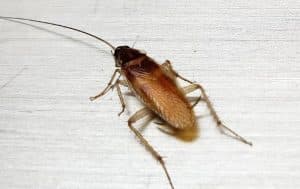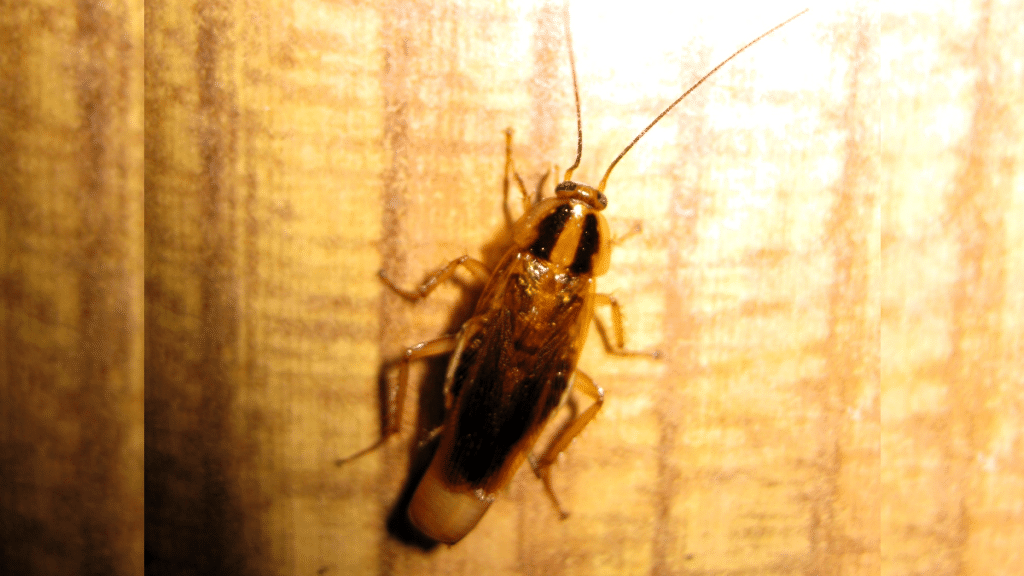The German cockroach is one of the most common pests that tend to invade apartments, houses, restaurants, and hotels around the world. These critters don’t just wander in from the outdoors – they ride in with our belongings, kitchen electrical appliances, luggage, and even in deliveries and shipping boxes. They’re high achievers in the pest world, with a very fast breeding cycle and a strong survival instinct, making them formidable opponents to eliminate.
German cockroaches ((Blattella germanica)) are relatively small compared to other cockroach species, typically measuring between 1.1 to 1.6 cm in length. They possess two distinct, parallel dark stripes running from their head to the base of their wings. Although they have wings, German cockroaches rarely fly, preferring to run. Their coloration ranges from light brown to tan, and you can sometimes spot younger nymphs, which are darker, almost black, with a single stripe down the middle of the back.
German cockroaches have a diverse palate – they aren’t picky eaters, feasting on almost anything they can find. They reproduce rapidly, with females producing one egg capsule filled with 30-40 eggs every three to four weeks. It’s no wonder infestations usually occur where we least want them: in kitchens and bathrooms. If their population gets dense enough, they will branch out to other areas, particularly if they are being disturbed by repellant insecticides. Never spray German cockroaches with pesticide, always feed them a bait. They are the most difficult cockroach species to control and strongly recommend engaging a professional pest control company.
German cockroaches may be small, but they pack a punch when it comes to causing problems. Let’s explore the damage and health risks associated with these persistent pests:
- Contaminated Food and Surfaces: German cockroaches are notorious for invading kitchens and pantries. They contaminate food, utensils, and cooking surfaces with their droppings, saliva, and shed exoskeletons. Consuming contaminated food can lead to gastrointestinal issues.
- Chewed Materials: They’ll chew on almost anything—paper, cardboard, fabric, and even electrical wiring. Damaged wires can cause short circuits, electrical fires, or malfunctioning appliances.
- Stains and Odors: Their feces and secretions leave unsightly stains on walls, floors, and furniture. The smell of their pheromones can become overpowering in large infestations.
This transient, high performing and fast breeding insect can be found in kitchens in the coldest and hottest climates in the world. They live with us in our environment and not outdoors. This is how they take out infamous top prize for the most common cockroach species in the world.

German Cockroaches – Unveiling the Reign of the World’s Most Common Pest.
Prepare to meet the German cockroach, a relentless invader of apartments, houses, restaurants, and hotels worldwide. Unlike other pests that simply wander in from outside, these critters hitch a ride on our belongings, kitchen appliances, luggage, and even deliveries. With their fast-breeding cycle and unmatched survival skills, they are formidable opponents that can be challenging to eliminate.
Measuring just 1.1 to 1.6 cm in length, German cockroaches (Blattella germanica) are relatively small compared to other species. They sport two dark stripes running parallel from head to wings and prefer running over flying. Their coloration varies from light brown to tan, while younger nymphs have a darker appearance with a single stripe down their back.
When it comes to food preferences, German cockroaches are not picky eaters and will feast on almost anything they find. Female cockroaches reproduce at an alarming rate, laying egg capsules filled with 30-40 eggs every few weeks. This explains why infestations commonly occur in kitchens and bathrooms where abundant food sources are available. If left unchecked or disturbed by repellent insecticides, their population will expand into other areas. It is highly advised to avoid spraying them with pesticides and instead use bait for control purposes. Engaging professional pest control services is strongly recommended due to their difficulty in eradication.
Despite their small size, German cockroaches can wreak havoc and pose health risks:
- Contaminated Food and Surfaces: Infamous for invading kitchens and pantries, they leave behind droppings, saliva, and shed exoskeletons that contaminate food, utensils, and cooking surfaces. Consuming contaminated food can lead to gastrointestinal issues.
- Damage from Chewing: They have an appetite for paper, cardboard fabric, and electrical wiring. Damaged wires can cause short circuits, electrical fires, or malfunctioning appliances.
- Stains and Odors: Their feces and secretions leave unsightly stains on walls, floors, and furniture. In large infestations, the smell of their pheromones becomes overpowering.
These highly adaptable insects thrive in kitchens across the globe, enduring both extreme cold and heat. They coexist with us in our environment rather than residing outdoors. It’s no wonder they claim the notorious title of being the most common cockroach species worldwide.

